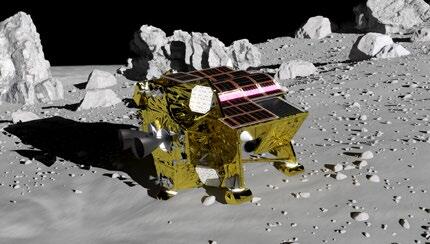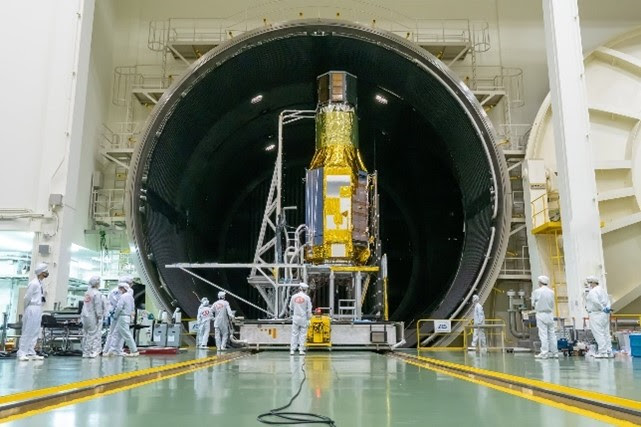Japan will launch SLIM moon lander and space telescope today after delays. Here's how to watch it live.
Liftoff is scheduled for 7:42 p.m. ET on Wednesday (Sept. 6).
Japan will shoot for the moon on Wednesday (Sept. 6).
The Japanese Aerospace Exploration Agency (JAXA) is planning to launch its Smart Lander for Investigating Moon (SLIM) mission, along with a space telescope called XRISM, on Wednesday at 7:42 p.m. EDT (2342 GMT; 8:42 a.m. Thursday Japan time).
You can watch it live here at Space.com, courtesy of JAXA. Coverage will start at 7:10 p.m. EDT (2310 GMT; 8:10 a.m. Japan time).
Related: Japan gearing up to launch SLIM moon 'moon sniper' lander

The launch has been delayed multiple times by bad weather, most recently on Aug. 28.
SLIM and XRISM will launch from Tanegashima Space Center atop Japan's H2-A rocket. SLIM's lunar landing, which is expected to occur four to six months from now, will be Japan's second attempt in recent months to put hardware on the moon's surface. An effort by the Tokyo-based company ispace failed during its landing try on April 25.
Also flying on the H-2A is the X-Ray Imaging and Spectroscopy Mission (XRISM) mission, which aims to scrutinize the universe in X-rays. That spacecraft is a collaboration involving JAXA, NASA and the European Space Agency (ESA).
Breaking space news, the latest updates on rocket launches, skywatching events and more!
SLIM is a small moon mission with big aims. The probe aims to demonstrate accurate lunar landing techniques with a precise touchdown. The mission plan calls for a landing no more than 328 feet (100 m) from a target inside the moon's Shioli Crater.
From there, the lander will examine the environment surrounding it in Shioli Crater, a 984-foot-wide (300 m) impact feature inside Mare Nectaris. The area is roughly at 13 degrees south latitude and 25 degrees east longitude, on the near side of the moon facing Earth.
If SLIM makes it safely to the surface, Japan will become just the fifth country to do so after the former Soviet Union, the United States, China and India. India just joined the group with the historic Aug. 23 touchdown of its Chandrayaan-3 rover-lander duo. (Other countries have made attempts, including Russia, whose Luna-25 lander recently crashed following an unsuccessful maneuver on Aug. 19.)

JAXA is a partner in the NASA-led Artemis Accords that are aiming for the moon while establishing peaceful norms in space. The accords have dozens of signatories so far, and Japan is among the nations actively participating in NASA's human moon program, called Artemis.
Last year, U.S. president Joe Biden and Japanese Prime Minister Fumio Kishida confirmed Japan will have a key role in Artemis missions.

A Japanese astronaut will go to NASA's planned Gateway moon-orbiting space station, and both Biden and Kishida have a "shared ambition" to put a Japanese astronaut on the moon, NASA officials stated at the time. (The first expected landing in the NASA program is Artemis 3, no earlier than 2025 or 2026, pending hardware readiness and the success of Artemis 2, a round-the-moon mission scheduled to launch in late 2024.)
Japan received its seats and science on board Artemis missions via a set of international pacts with the U.S. The agreements span matters such as cybersecurity, 5G cellular networks and science and technology collaborations, a White House explainer document stated.
Editor's note: This article was corrected on Sept. 7 to correctly reflect the countries that have landed on the moon.
Join our Space Forums to keep talking space on the latest missions, night sky and more! And if you have a news tip, correction or comment, let us know at: community@space.com.

Elizabeth Howell (she/her), Ph.D., was a staff writer in the spaceflight channel between 2022 and 2024 specializing in Canadian space news. She was contributing writer for Space.com for 10 years from 2012 to 2024. Elizabeth's reporting includes multiple exclusives with the White House, leading world coverage about a lost-and-found space tomato on the International Space Station, witnessing five human spaceflight launches on two continents, flying parabolic, working inside a spacesuit, and participating in a simulated Mars mission. Her latest book, "Why Am I Taller?" (ECW Press, 2022) is co-written with astronaut Dave Williams.
